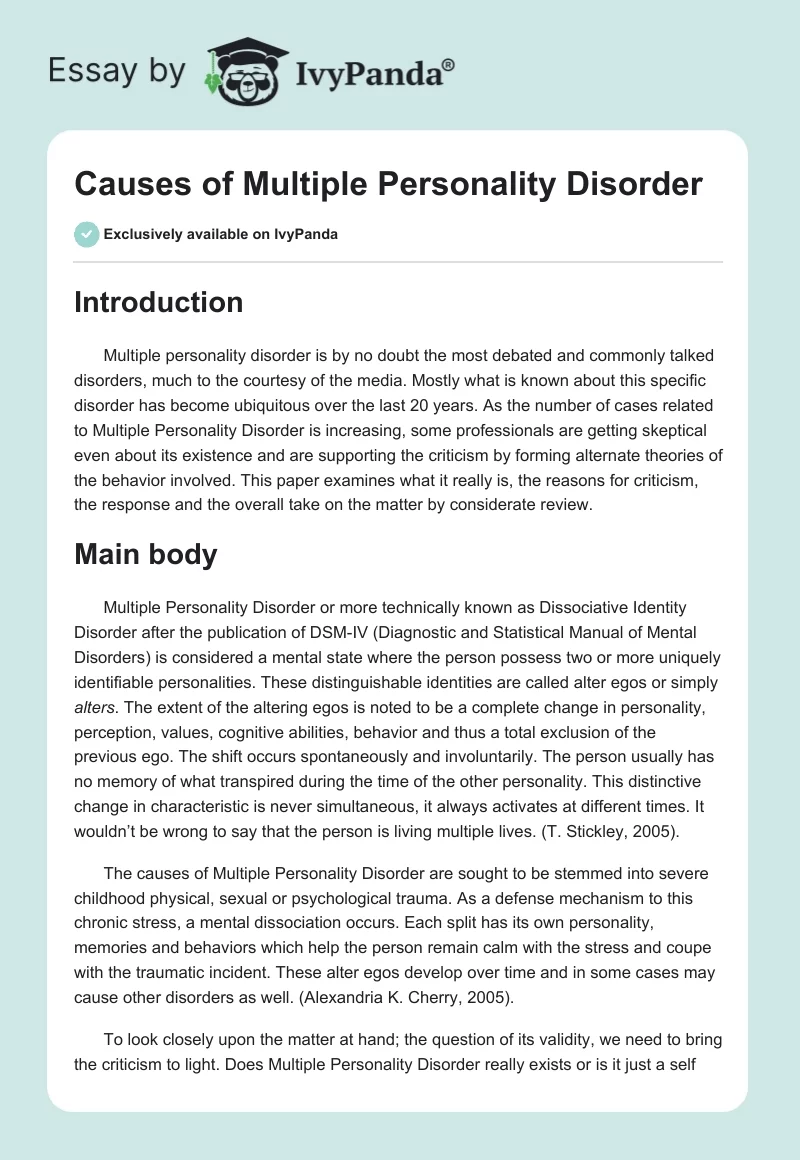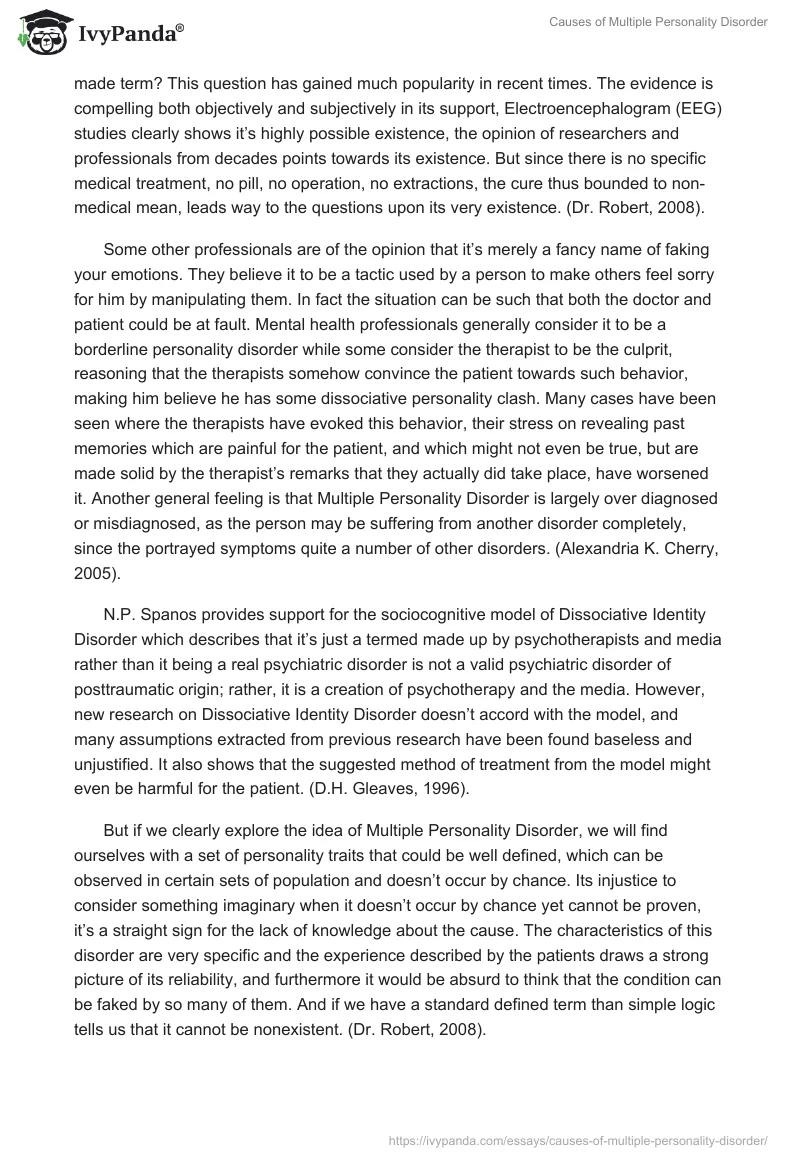Introduction
Multiple personality disorder is by no doubt the most debated and commonly talked disorders, much to the courtesy of the media. Mostly what is known about this specific disorder has become ubiquitous over the last 20 years. As the number of cases related to Multiple Personality Disorder is increasing, some professionals are getting skeptical even about its existence and are supporting the criticism by forming alternate theories of the behavior involved. This paper examines what it really is, the reasons for criticism, the response and the overall take on the matter by considerate review.
Main body
Multiple Personality Disorder or more technically known as Dissociative Identity Disorder after the publication of DSM-IV (Diagnostic and Statistical Manual of Mental Disorders) is considered a mental state where the person possess two or more uniquely identifiable personalities. These distinguishable identities are called alter egos or simply alters. The extent of the altering egos is noted to be a complete change in personality, perception, values, cognitive abilities, behavior and thus a total exclusion of the previous ego. The shift occurs spontaneously and involuntarily. The person usually has no memory of what transpired during the time of the other personality. This distinctive change in characteristic is never simultaneous, it always activates at different times. It wouldn’t be wrong to say that the person is living multiple lives. (T. Stickley, 2005).
The causes of Multiple Personality Disorder are sought to be stemmed into severe childhood physical, sexual or psychological trauma. As a defense mechanism to this chronic stress, a mental dissociation occurs. Each split has its own personality, memories and behaviors which help the person remain calm with the stress and coupe with the traumatic incident. These alter egos develop over time and in some cases may cause other disorders as well. (Alexandria K. Cherry, 2005).
To look closely upon the matter at hand; the question of its validity, we need to bring the criticism to light. Does Multiple Personality Disorder really exists or is it just a self made term? This question has gained much popularity in recent times. The evidence is compelling both objectively and subjectively in its support, Electroencephalogram (EEG) studies clearly shows it’s highly possible existence, the opinion of researchers and professionals from decades points towards its existence. But since there is no specific medical treatment, no pill, no operation, no extractions, the cure thus bounded to non-medical mean, leads way to the questions upon its very existence. (Dr. Robert, 2008).
Some other professionals are of the opinion that it’s merely a fancy name of faking your emotions. They believe it to be a tactic used by a person to make others feel sorry for him by manipulating them. In fact the situation can be such that both the doctor and patient could be at fault. Mental health professionals generally consider it to be a borderline personality disorder while some consider the therapist to be the culprit, reasoning that the therapists somehow convince the patient towards such behavior, making him believe he has some dissociative personality clash. Many cases have been seen where the therapists have evoked this behavior, their stress on revealing past memories which are painful for the patient, and which might not even be true, but are made solid by the therapist’s remarks that they actually did take place, have worsened it. Another general feeling is that Multiple Personality Disorder is largely over diagnosed or misdiagnosed, as the person may be suffering from another disorder completely, since the portrayed symptoms quite a number of other disorders. (Alexandria K. Cherry, 2005).
N.P. Spanos provides support for the sociocognitive model of Dissociative Identity Disorder which describes that it’s just a termed made up by psychotherapists and media rather than it being a real psychiatric disorder is not a valid psychiatric disorder of posttraumatic origin; rather, it is a creation of psychotherapy and the media. However, new research on Dissociative Identity Disorder doesn’t accord with the model, and many assumptions extracted from previous research have been found baseless and unjustified. It also shows that the suggested method of treatment from the model might even be harmful for the patient. (D.H. Gleaves, 1996).
But if we clearly explore the idea of Multiple Personality Disorder, we will find ourselves with a set of personality traits that could be well defined, which can be observed in certain sets of population and doesn’t occur by chance. Its injustice to consider something imaginary when it doesn’t occur by chance yet cannot be proven, it’s a straight sign for the lack of knowledge about the cause. The characteristics of this disorder are very specific and the experience described by the patients draws a strong picture of its reliability, and furthermore it would be absurd to think that the condition can be faked by so many of them. And if we have a standard defined term than simple logic tells us that it cannot be nonexistent. (Dr. Robert, 2008).
The overlapping of Dissociative Identity Disorders to other disorders, having no relation with trauma or its wide scale diagnosis due to popularity, is a view held by the promoters of Dissociative Identity Disorder iatrogenesis hypothesis. However, scientific systematic review done by Dissociate Experience Scales and Structured Clinical Interview provides the result that shows a distinguished set of features for the Dissociate Identity Disorder from the other disorders. These studies also show that there is no significant relation of Dissociative Identity Disorder with attention seeking traits. Also, the hypothesis remains silent for the fact that many of the diagnosed patients had a considerable history of dissociative symptoms. (Neil Brick, 2003).
Much of the physical evidence tells us about the physiological variations such as degree of tolerance, vision, asthma, response to different medicines and headaches. A patient might suffer from some, all or more of the aforementioned ailments. Brain scans of a person’s alter egos reveal differences, which obviously cannot be intentionally simulated. Even normal psychological test shows the differences of susceptible Dissociative Identity Disorder patients. (Neil Brick, 2003).
The arguments from both sides; persons who thinks that its nothing more than a popularized and hyped term coined abstractly and the ones who think that it is a real psychological disorder, goes on forever and the controversy between them is increasing. Skeptics provide us with the complete denial of Multiple Personality Disorder, given a picture of some sort of escape plan for the mentally insecure, originated mostly by the biased behavior of therapists or attention seeking individuals and a way to fake and be someone else while completely having no responsibility to the consequences of the pseudo alter ego. Still the conventional researchers defend their selves by taking up the shield of vast amount of scientific facts and figures, formalized methodologies of diagnosis, and experimental explanations.
Conclusion
These researches may go on and on but one strand of common thought suggests that there is something real in this type of behavior. That these numerous examples may very well be denied but the fact that these occurred in a similar fashion points to at least the existence of such phenomenon. However, skepticism may very well be right in pointing out the negligence of the actual classification of this term. More research needs to be done into what actually makes this behavior a personality disorder, how genuinely the causes relate to the symptoms and what if it all is a very natural condition? Possibilities should not be overlooked.
References
Alexandria K. Cherry, Multiple Personality Disorder: Fact or Fiction? (2005). Web.
D.H. Gleaves, The sociocognitive model of dissociative identity disorder: a reexamination of the evidence. (1996). Web.
Dr. Robert Zee, Multiple Personality Disorder. Truth or Fiction? (2008). Web.
Neil Brick, The Etymological Antecedents of and Scientific Evidence for the Existence of Dissociative Identity Disorder (2003). Web.
T. Stickley, Becoming one person: living with dissociative identity disorder (2005). Web.


